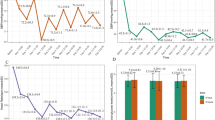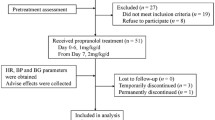Abstract
Purpose
β2-sympathomimetics are used in obstetrics as tocolytic agents, despite a remarkable profile of side effects. Recently, the β2-sympathomimetic tocolytic drug hexoprenaline was identified as an independent risk factor for the development of infantile hemangioma (IH) in preterm infants. The aim of this study was to evaluate whether this observed effect was applicable to other β2-mimetic tocolytic agents like fenoterol.
Methods
Clinical prospectively collected data of all infants born between 2001 and 2012 and admitted to the neonatal intensive care unit (NICU) at Heidelberg University Hospital and respective maternal data were merged. For the current retrospective cohort study, cases (IH) were matched to controls (no IH) at a ratio of 1:4, adjusting for birth weight, gestational age, gender and multiple gestations. Prenatal exposure to fenoterol and perinatal outcome were analyzed in the total cohort and in subgroups.
Results
N = 5070 infants were admitted to our neonatal department, out of which n = 172 infants with IH were identified and compared to n = 596 matched controls. Exposure to fenoterol was not associated with a higher rate of IH in the total matched population (OR 0.926, 95% CI 0.619–1.384) or in a subgroup of neonates < 32 weeks of gestation or with a birth weight < 1500 g (OR 1.127, 95% CI 0.709–1.791). In the total matched population, prenatal exposure to glucocorticoids was associated with a reduced occurrence of IH (OR 0.566, 95% CI 0.332–0.964) and neonates with IH showed a prolonged total hospital stay compared to controls (69 vs. 57 days, p = 0.0033). Known risk factors for IH were confirmed by our large study cohort and included female gender, low birth weight, preterm birth and multiple gestations (all p < 0.005).
Conclusions
Exposure to fenoterol during pregnancy does not increase the occurrence of IH. Further studies are needed to explore differences in the risk profiles of different β2-sympathomimetic tocolytic drugs.

Similar content being viewed by others
References
Blencowe H, Cousens S, Chou D et al (2013) Born too soon: the global epidemiology of 15 million preterm births. Reprod Health 10(Suppl 1):S2
Martin JA, Hamilton BE, Ventura SJ et al (2013) Births: final data for 2011. Natl Vital Stat Rep 62(1):1–69–1–72
Beck S, Wojdyla D, Say L et al (2010) The worldwide incidence of preterm birth: a systematic review of maternal mortality and morbidity. Bull World Health Organ 88:31–38. https://doi.org/10.2471/BLT.08.062554
Haas DM, Caldwell DM, Kirkpatrick P et al (2012) Tocolytic therapy for preterm delivery: systematic review and network meta-analysis. BMJ 345:e6226
Haas DM, Imperiale TF, Kirkpatrick PR et al (2009) Tocolytic therapy: a meta-analysis and decision analysis. Obstet Gynecol 113:585–594. https://doi.org/10.1097/AOG.0b013e318199924a
de Heus R, Mol BW, Erwich J-JHM et al (2009) Adverse drug reactions to tocolytic treatment for preterm labour: prospective cohort study. BMJ 338:b744
Mayer M, Minichmayr A, Klement F et al (2013) Tocolysis with the β-2-sympathomimetic hexoprenaline increases occurrence of infantile haemangioma in preterm infants. Arch Dis Child Fetal Neonatal Ed 98:F108–F111. https://doi.org/10.1136/archdischild-2011-301030
Frieden IJ, Haggstrom AN, Drolet BA et al (2005) Infantile hemangiomas: current knowledge, future directions. Proceedings of a research workshop on infantile hemangiomas, April 7–9, 2005, Bethesda, Maryland, USA. In: Pediatr Dermatol, pp 383–406
Léauté-Labrèze C, Harper JI, Hoeger PH (2017) Infantile haemangioma. Lancet 390:85–94. https://doi.org/10.1016/S0140-6736(16)00645-0
Drolet BA, Esterly NB, Frieden IJ (1999) Hemangiomas in children. N Engl J Med 341:173–181. https://doi.org/10.1056/NEJM199907153410307
Drolet BA, Swanson EA, Frieden IJ, Hemangioma Investigator Group (2008) Infantile hemangiomas: an emerging health issue linked to an increased rate of low birth weight infants. J Pediatr 153:712–715e1. https://doi.org/10.1016/j.jpeds.2008.05.043
Kilcline C, Frieden IJ (2008) Infantile hemangiomas: how common are they? A systematic review of the medical literature. Pediatr Dermatol 25:168–173. https://doi.org/10.1111/j.1525-1470.2008.00626.x
Dclalz MD, Pjih MD, Pphh MD (2017) Infantile haemangioma. Lancet 390:85–94. https://doi.org/10.1016/S0140-6736(16)00645-0
Smith CJF, Friedlander SF, Guma M et al (2017) Infantile hemangiomas: an updated review on risk factors, pathogenesis, and treatment. Birth Defects Res 109:809–815. https://doi.org/10.1002/bdr2.1023
Hunjan MK, Schoch JJ, Anderson KR et al (2017) Prenatal risk factors for infantile hemangioma development. J Invest Dermatol 137:954–957. https://doi.org/10.1016/j.jid.2016.10.047
Siegfried EC, Keenan WJ, Al-Jureidini S (2008) More on propranolol for hemangiomas of infancy. N Engl J Med 359:2846. https://doi.org/10.1056/nejmc086443 (author reply 2846–7)
Léauté-Labrèze C, la Roque de ED, Hubiche T et al (2009) Propranolol for severe hemangiomas of infancy. N Engl J Med 358:2649–2651. https://doi.org/10.1056/nejmc0708819
Manunza F, Syed S, Laguda B et al (2010) Propranolol for complicated infantile haemangiomas: a case series of 30 infants. Br J Dermatol 162:466–468. https://doi.org/10.1111/j.1365-2133.2009.09597.x
Woody MM, Levy ML, Weinfeld AB (2016) Propranolol for preoperative management of a large infantile hemangioma. Pediatr Dermatol 33:e198–e200. https://doi.org/10.1111/pde.12850
Ames JA, Sykes JM (2015) Current trends in medical management of infantile hemangioma. Curr Opin Otolaryngol Head Neck Surg 23:286–291. https://doi.org/10.1097/MOO.0000000000000170
Murphy SN, Mendis M, Hackett K et al (2007) Architecture of the open-source clinical research chart from Informatics for Integrating Biology and the Bedside. AMIA Annu Symp Proc 2007:548–552
Karmen C, Ganzinger M, Kohl CD et al (2014) A framework for integrating heterogeneous clinical data for a disease area into a central data warehouse. Stud Health Technol Inform 205:1060–1064
Kawabata H, Tran M, Hines P (2004) Using SAS® to match cases for case control studies. SUGI 29. Princeton, New Jersey, 173–29
Annabi B, Lachambre M-P, Plouffe K et al (2009) Propranolol adrenergic blockade inhibits human brain endothelial cells tubulogenesis and matrix metalloproteinase-9 secretion. Pharmacol Res 60:438–445. https://doi.org/10.1016/j.phrs.2009.05.005
Storch CH, Hoeger PH (2010) Propranolol for infantile haemangiomas: insights into the molecular mechanisms of action. Br J Dermatol 163:269–274. https://doi.org/10.1111/j.1365-2133.2010.09848.x
Murphy KE, Willan AR, Hannah ME et al (2012) Effect of antenatal corticosteroids on fetal growth and gestational age at birth. Obstet Gynecol 119:917–923. https://doi.org/10.1097/AOG.0b013e31825189dc
Haggstrom AN, Drolet BA, Baselga E et al (2006) Prospective study of infantile hemangiomas: clinical characteristics predicting complications and treatment. Pediatrics 118:882–887. https://doi.org/10.1542/peds.2006-0413
Greco MF, Frieden IJ, Drolet BA et al (2016) Infantile hemangiomas in twins: a prospective cohort study. Pediatr Dermatol 33:178–183. https://doi.org/10.1111/pde.12781
Munden A, Butschek R, Tom WL et al (2014) Prospective study of infantile haemangiomas: incidence, clinical characteristics and association with placental anomalies. Br J Dermatol 170:907–913. https://doi.org/10.1111/bjd.12804
Dickison P, Christou E, Wargon O (2011) A prospective study of infantile hemangiomas with a focus on incidence and risk factors. Pediatr Dermatol 28:663–669. https://doi.org/10.1111/j.1525-1470.2011.01568.x
Author information
Authors and Affiliations
Contributions
H Hudalla: protocol/project development, data collection or management, data analysis and manuscript writing/editing. C Karmen: data collection or management. T Bruckner: data collection or management and data analysis. S Wallwiener: manuscript editing. H Fluhr: manuscript editing. Z Michael: manuscript editing. A Freis: manuscript editing. H Maul: manuscript editing. T Strowitzki: manuscript editing. J Pöschl: manuscript editing. RJ Kuon: protocol/project development, data collection or management, data analysis and manuscript writing/editing.
Corresponding author
Ethics declarations
Conflict of interest
The authors declare that they have no conflict of interest.
Funding
None declared.
Ethical approval
The study was approved by the Heidelberg University institutional review board (Ethikkommission der Medizinischen Fakultät Heidelberg, Alte Glockengießerei 11/1, 69115 Heidelberg, Germany, IRB number: S-094/2013). All procedures performed in studies involving human participants were in accordance with the ethical standards of the institutional and/or national research committee and with the 1964 Helsinki Declaration and its later amendments or comparable ethical standards.
Informed consent
Requirement for inform consent has been waived by the Heidelberg University institutional review board (Ethikkommission der Medizinischen Fakultät Heidelberg, IRB number: S-094/2013) due to the retrospective nature of the study and pseudonymization of data.
Rights and permissions
About this article
Cite this article
Hudalla, H., Karmen, C., Bruckner, T. et al. Tocolysis with the β2-sympathomimetic fenoterol does not increase the occurrence of infantile hemangioma in preterm and term infants. Arch Gynecol Obstet 298, 521–527 (2018). https://doi.org/10.1007/s00404-018-4830-5
Received:
Accepted:
Published:
Issue Date:
DOI: https://doi.org/10.1007/s00404-018-4830-5




